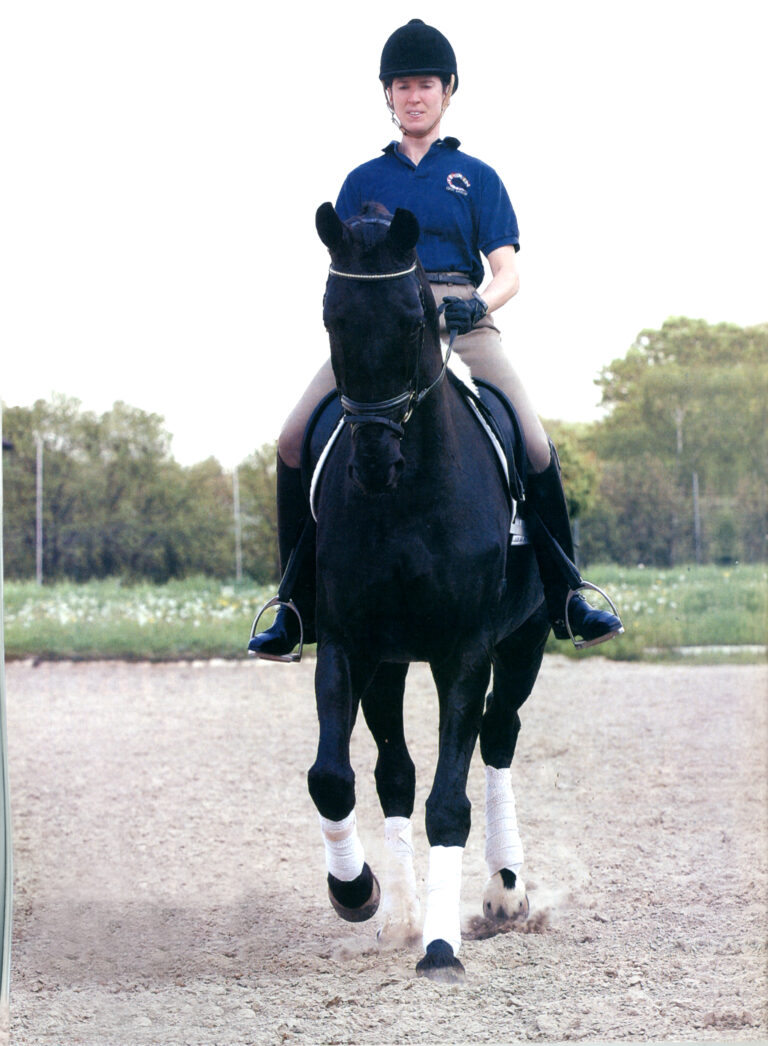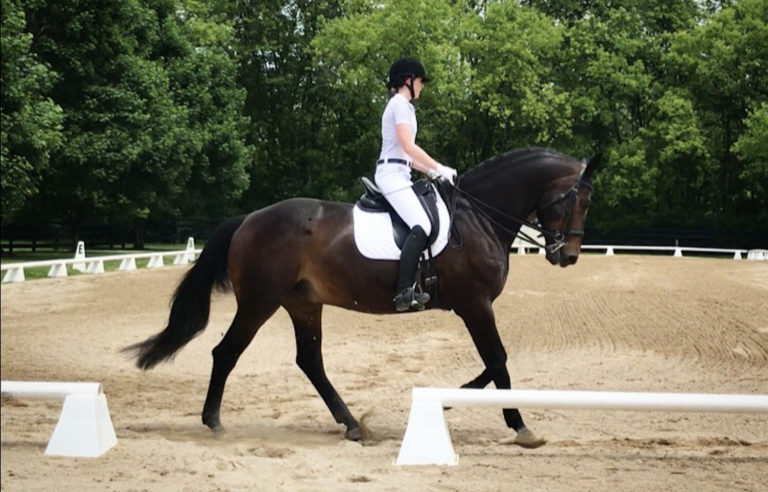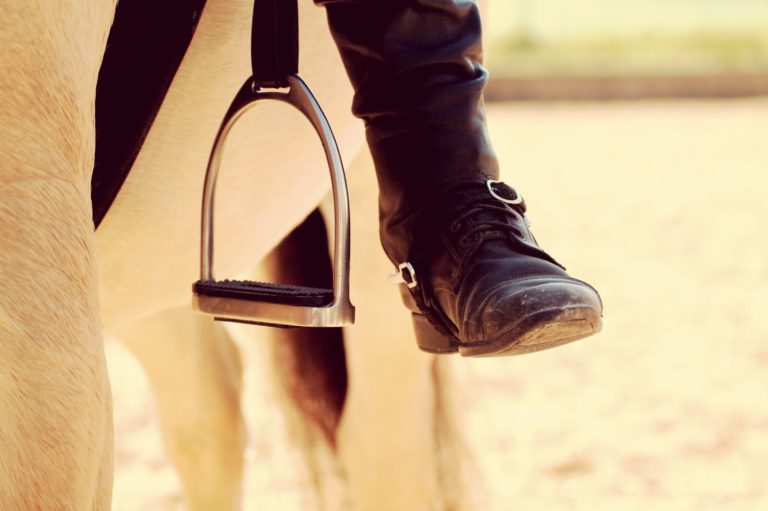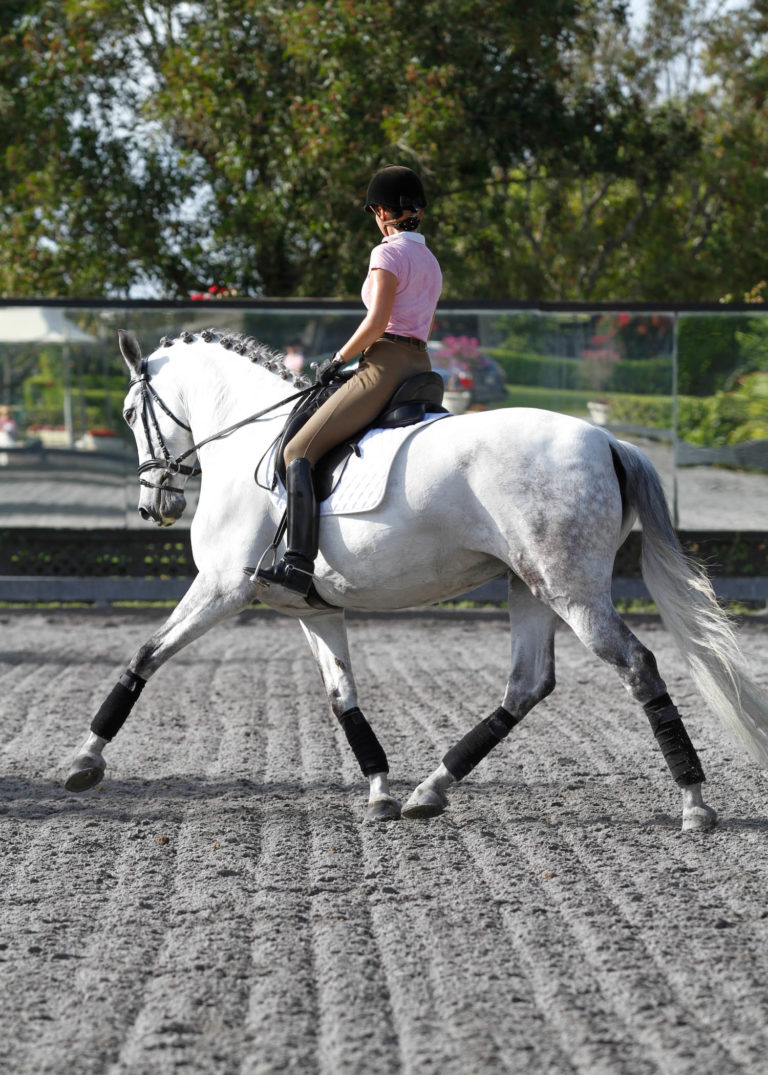True riding is an endless search for synchrony and harmony—you can get it today and lose it tomorrow. This search is no overnight affair. It is a progression of steps, measured in tiny increments of success, in an endless journey of challenge and discovery.

Because we must communicate within equine terms, a rider must learn to speak clearly with his body signals—the aids. He is not born with these instincts. Only when he knows precisely what he is saying to his horse and is able to listen acutely to his horse’s answers, has he mastered the horse–human relationship. Let us review the rider’s seat, upper body, hands and arms, legs and weight to better understand this.
The Seat
The rider’s seat is closely interconnected with the way in which the horse moves and, therefore, they are dependent upon each other. A good seat can be recognized by the way it adjusts to the horse’s movement. A bad seat can interfere with the horse’s movement to a point that a well-trained horse can no longer show his quality. The bad seat is accompanied by noisy, noticeable aids that tend to interfere with the total picture (the overall impression) in an unflattering way.
The seat of the rider and the influence he has on the horse show his artistic ability. The highest level of skill is demonstrated by quiet, invisible, perfectly timed aids that influence the horse immediately. This is always a result of a rider who can sit well on a supple horse that is forward and swinging. That is the point where the technique of riding becomes the art of riding (Reitkunst). The rider’s seat is correct when it is well-balanced—that is, his center of balance is constantly in harmony with that of his horse. His buttocks should never leave the saddle. His loins and hips are supple with thighs and legs that are steady and well-stretched downward. All laboring work and movement with the body are faulty. The rider’s seat will stay glued to the saddle only if he sits on the horse’s back with totally relaxed muscles and legs that hang down naturally from relaxed hips. When this middle part of the body, from the hips over the loin to the upper leg, is relaxed, the body swings in smooth, flowing arcs. This correct seat assures a light contact and use of the reins. Riding without stirrups can improve the relaxation of the seat. For a correct seat there are three points of significance. The seat:
1. moves in harmony with the movement of the horse
2. is relaxed and supple
3. gives correct, invisible aids.
Out of this relaxed, harmonious and deep-seated position the rider can give well-timed aids. For example, the rider’s lower leg automatically comes more into contact with the horse’s body at the moment when the horse steps forward with his hind foot. As a result, the horse naturally receives a perfectly timed impulse from the rider’s lower leg, asking him to step more forward.
The seat aid itself is of great importance in dressage. Only the rider who understands how to brace (contract) his loin and back muscles at any moment is able to influence his horse correctly. The bracing of the back is developed when the rider quickly resists with his spine, which serves to strengthen the seat and weight aids.
The Upper Body
The upper part of the rider’s body should be easy, free and erect. The shoulders are quite naturally relaxed and the shoulder blades are together. The rider’s spine gives his seat stability. All of the rider’s aids start and end in his back (spine). The rider has to keep his upper body, including his hips, perpendicular to the back of the horse.
One can never drive his horse forward by leaning backward. He would disturb the horse by coming behind the movement, making it difficult for him to bring his hind legs forward under the point of gravity.
The Hands and Arms
The hands are low and close together; the elbows and arms are close to the body, thus enabling the rider to follow the horse’s movements smoothly and freely. The rider is then able to apply the aids unobtrusively.
In profile, the lower arm, hand, wrist and rein form a straight, unbroken line to the horse’s mouth. Hands should always show a tendency down toward the saddle instead of going up. This is the only position in which the rider can school his horse progressively and correctly. If there is any strain in the arm, the rider cannot handle the reins with sensitivity. If the hands pull, the horse will become resentful and difficult.
The horse must feel that he can confidently march forward without any interference from the rider’s hands. The skilled rider is able to keep the contact with his reins and prevent hanging reins despite the body’s movement. An experienced rider does not use his hands as the primary control, but uses them in conjunction with driving aids.
The horse’s acceptance of the bridle and the rider’s requests for yielding and flexion should never be achieved by hands that pull backward. They should be a result of impulsion and activity of the hind legs against a steady, opposing hand. High-carried shoulders and open-stuck elbows are faulty. High hands with short reins give the impression that the horse’s neck is cut into two pieces by reins that make the neck shorter. The higher the hands rise, the more the horse’s head will come behind the perpendicular. This happens especially when riding on the curb bit.
The Legs
The lower leg should control the horse’s hindquarters as if he were between two walls or boundaries. The use of the spur is a legal tool to increase the effectiveness of the leg. The spur stimulates and contracts the muscle so it should be used only briefly, otherwise, it provokes disobedience and rebellious behavior.
The rider’s knees must lie deep and steady on the saddle, neither open nor pressed to the saddle. The right placement of the knees depends on the thighs lying correctly. They must be turned toward the horse and taken so far back that the knees are able to lie flat on the saddle. A lower leg that lies too far back is just as big of a mistake as the leg that is stretched forward or standing in the stirrups.
The calves or lower legs must lie in a steady, soft contact that can feel the hair of the horse’s body without pressing. Unsteady calves deaden the horse’s sensitivity for the driving aids. A soft, spring-like elasticity in the rider’s ankle joints is a true sign of a relaxed seat.
The Weight
When a rider uses his weight aids, his seat or buttocks should not be pushed to the side or collapsed in the hip. The shifting of a rider’s weight should be a result of the turning of the torso toward the inside. The rider’s shoulders rotate so they remain parallel to the shoulders of the horse. Shifting the rider’s weight to the wrong side or exaggerated leaning forward or backward will impact the balance of the horse and rider. This has to be equalized by the horse if he wants to stay well in balance.
Putting it TogetherA prerequisite of effective aids is a high degree of throughness or permeability in the horse (Durchlässigkeit in German). In this state of throughness, the pathway is free for the energy coming from his hindquarters to go through the horse’s back to the bit. When the horse is tense, the energy cannot go through. In order to achieve this throughness, the horse should stay on the rider’s aids: in front of his legs, on the seat and to the hand. The harmonious combination of aids is most important for the art of riding and the ability of the horse to carry out exercises. Always take care that the weight, leg and rein aids are used without exception in the above-mentioned sequence. Only then can you speak of aids working from the back to the front. Imagine a triangle of aids: The triangle begins from the rider’s foot. It goes up the leg to the rider’s back and then through his arm and rein to the bit and finally back to the rider’s foot again. The horse has to stay within this triangle of aids. Great riders share an uncanny ability to know exactly what the horse is going to do before he does it. The difference between good and great is a fine-tuned sense of anticipation—the art of reading a subtle clue that a change is coming and acting on it. The longer you ride in life, the more you recognize that learning never comes to an end.
Mind these three Ts and hear their chime: “Things take time!” A great rider is always firm but, at the same time, humble in his heart. He is always conscious that he is dealing with living creatures and that he has a wonderful opportunity to educate not only the horse but also himself. Riders have a great responsibility and duty to train and school after the classical principles, thus working for the benefit and sake of our equitation, demonstrating not only a fine feeling for riding but also its artistic beauty.
Dr. Josef Knipp is a retired FEI judge who has bred and trained horses in Germany for more than 40 years. He has officiated at several international championships around the world and has been a Dressage Today advisor for many years. He says it is important to train horses in the classical way rather than use modern methods such as hyperflexion. “If the rider fails to be in tune with his horse,” he explains, “the entire training has failed. Straying from the classical training will result in the end of dressage.”










